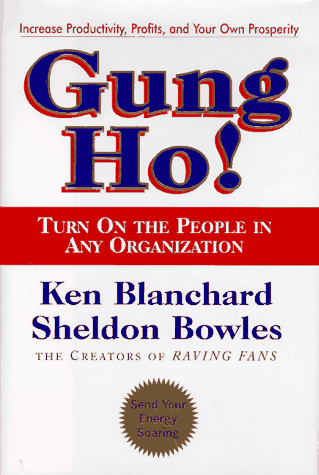
01 May Lets get Gung Ho!!!
Gung Ho! By: Ken Blanchard and Sheldon Bowles
Gung Ho! prescribes a three-phase method to motivate and energize any group or organization to achieve shared success.
Phase 1: The Spirit of the Squirrel. This phase transforms work to make it worthwhile to the team members. It consists of the following three steps.
First. Help the team members understand how their work benefits the world. This refers to the social value of the work which lies beyond the business value delivered by the team. From this understanding comes self-esteem which is a very powerful motivator.
Second. Define goals that are understood and shared by the team members. Set two or three critical goals and let the team set the remaining shared goals. From shared goals come buy-in and commitment of the team members to meet the goals. The support for goals comes from the trust of the team members in the management. Trust comes from telling the truth and sharing information with all team members. The other important factor is putting the team members first e.g. safeguard their health and safety.
Third. Define values that will guide the team members’ activities to reach the defined goals. Values are the master of the Gung Ho! process. Without it, Gung Ho! will fail. Values come from the team and management. Every value is critical. You can compromise on goals but never on values. A value once defined never changes and has to hold all the time. Otherwise, a value loses its meaning.
Phase 2. The Way of the Beaver. This phase enables team members to take charge to achieve the shared goals. These goals and the values that were set in the previous phase describe what needs to be achieved and the rules within which it has to be achieved. Once the team members execute within the rules they are free to select how they reach their targets. This phase can be broken down in the following three steps.
First. The management determines the roles of each team member and the scopes and responsibilities of these roles. The management must then move out and let each member take control to execute within their defined territories. In setting the roles of a team member, the management should know his/her natural abilities and then adapt the roles to take advantage of these strengths. The other way is rarely effective.
Second. The management ensures that the team members are valued. This is done by respecting and taking action on an individual’s ideas, wants, feelings and aspirations. Also, accurate information needs to be fully and freely shared among team members.
Third. Each team member is challenged in a way that is at par with his/her capacity but at the same time stretches it as well. This allows people to learn and grow their abilities.
Phase 3. The Gift of the Goose. This phase encourages the team members on their road to success. There are three parts to it.
First. Team members must be constantly reminded of their value and contribution to their shared goals. A member should be congratulated often on his/her job. Congratulations can either be active or passive. In an active congratulation, an employee is officially recognized by announcing his/her achievements and/or presenting an award. A passive congratulation is a silent acknowledgment of trust on a person’s capability to execute his/her responsibility. In such an event, the management steps aside and let the individual take charge without providing any advice or exercising control. Congratulations have to be TRUE – Timely, Responsive, Unconditional, and Enthusiastic.
Second. Progress besides the result must be cheered upon. This shares the measurement of progress (of achieving the shared goals) and generates excitement among team members. Congratulations are most effective when these are Spontaneous (instead of being Programmed), Individual (instead of being Blanket), Specific (instead of being General) and Unique (instead of being Traditional). Management must practice coaching instead of policing behavior. Thus, it should look out for employees who have produced successful results and move away from focusing on failures and members who are responsible for them.
Third. Enthusiasm of the mission must be sustained by cheering and rewards. The mission consists of worthwhile work and being in charge of achieving it. The members must cheer each other to enthuse themselves. Cash should the first reward option as it address the basic needs of an employee. Non-monetary rewards come after this. This is captured by E = mc2, Enthusiasm is equal to the Mission multiplied by Cash and Congratulations.
cited by Ken Blanchard and Sheldon Bowles.

